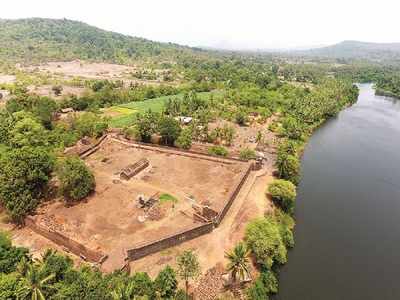- News
- Alorna fort: An identity lost and found
This story is from June 28, 2018
Alorna fort: An identity lost and found

A general view of the Alorna fort
Memories of the riverfront citadel of Alorna in Pernem, once described as ‘exemplary of military architecture’ have all but faded into oblivion. But there was a time when many bitter battles were fought over its possession.
The department of archives and archaeology is now reviving the fort after more than a century of neglect. The effort will be a meticulous one, including referring to sketches by a Portuguese explorer and researcher, and studying the original construction materials while keeping in mind future maintenance.
Looking at the ruins of this small, irregular fort, situated in an obscure northeastern corner of Pernem, the wrangling over it the Portuguese, Bhonsles and Marathas might seem baffling, that is, till one comprehends the strategic importance of its location.
With a history spanning almost a hundred years — late 17th to late 18th century — the fort is devoid on the inside of any semi-residential structures. It served more as a fortification to repel enemy attacks at a critical time in the history of Goa.
The location of the fort was so strategic that after the Bhonsles lost it to the Portuguese and were handed it back by a royal decree, the Portuguese found that they just couldn’t let go of it. They attacked again and took back the fort.
Portuguese explorer António Lopes Mendes describes Alorna fort and the area in his seminal book, ‘A India Portuguesa’, “The moat, formed by two thick fences of land, is still covered here and there with dense bamboo, which at the time of conquest was impenetrable, and under which the Marathas offered strong resistance.”
With almost no other known documentation on the fort and its architecture, it is to Mendes’ pictorial references of the fort that the department of archives and archaeology is turning in its bid to restore the heritage structure.
The department is keen to make this restoration effort self-sustaining, and will be using original building materials, including jaggery as a binding agent, in the reconstruction. When restored, the fort, which has one of the most scenic views of the Chapora river, ought to draw attention once again.
"Restoration is not an end in itself, the maintenance will continue for years and we have a schedule mapped out," says conservation architect Ketak Nachinolkar.
The department of archives and archaeology is now reviving the fort after more than a century of neglect. The effort will be a meticulous one, including referring to sketches by a Portuguese explorer and researcher, and studying the original construction materials while keeping in mind future maintenance.
Looking at the ruins of this small, irregular fort, situated in an obscure northeastern corner of Pernem, the wrangling over it the Portuguese, Bhonsles and Marathas might seem baffling, that is, till one comprehends the strategic importance of its location.
With a history spanning almost a hundred years — late 17th to late 18th century — the fort is devoid on the inside of any semi-residential structures. It served more as a fortification to repel enemy attacks at a critical time in the history of Goa.
It was built before the Portuguese occupation of these parts, and was originally constructed by the Bhonsles of Sawantwadi as a defence against the bothersome Maratha attacks and to also protect their territories of Pernem, Maneri and Bicholim, and the river passage from the Portuguese.
The location of the fort was so strategic that after the Bhonsles lost it to the Portuguese and were handed it back by a royal decree, the Portuguese found that they just couldn’t let go of it. They attacked again and took back the fort.
Portuguese explorer António Lopes Mendes describes Alorna fort and the area in his seminal book, ‘A India Portuguesa’, “The moat, formed by two thick fences of land, is still covered here and there with dense bamboo, which at the time of conquest was impenetrable, and under which the Marathas offered strong resistance.”
With almost no other known documentation on the fort and its architecture, it is to Mendes’ pictorial references of the fort that the department of archives and archaeology is turning in its bid to restore the heritage structure.
The department is keen to make this restoration effort self-sustaining, and will be using original building materials, including jaggery as a binding agent, in the reconstruction. When restored, the fort, which has one of the most scenic views of the Chapora river, ought to draw attention once again.
"Restoration is not an end in itself, the maintenance will continue for years and we have a schedule mapped out," says conservation architect Ketak Nachinolkar.
End of Article
FOLLOW US ON SOCIAL MEDIA
